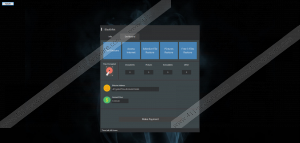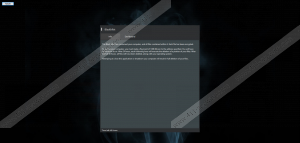Blackmist Ransomware Removal Guide
Blackmist Ransomware is a new danger to your precious files if somehow it can sneak onto your system. Although this ransomware infection seems to be still in development, it does not mean it cannot cause proper devastation on your system. In fact, this malicious program can encrypt your important files in a very short time and render them useless and inaccessible for you in order to push you to pay the ransom fee. These attackers use scare tactics as well to push you even more towards wanting to transfer the fee. Unlike in the case of most of the other ransomware attacks, these crooks offer you different options and amounts to pay. Still, we believe that it is always risky to pay any amount to cyber criminals, let alone the fact that this would simply mean supporting cybercrime. Since this dangerous program can also restart with your Windows operating system, there is no other choice really than to remove Blackmist Ransomware as soon as possible. The only possible way to have your files recovered is to have a recent backup saved in cloud storage or on a removable hard disk. Please continue reading our article to find out more about this vicious ransomware-to-be.
There are indeed a number of ways how this ransomware may infiltrate your system, and most of these require your part in it. This means, of course, that in most cases it is actually you who lets this dangerous infection onto your system. How could this happen? Let us explain in more details. One of the most widely used distribution methods is spamming campaigns. Cyber criminals can reach lots of unsuspecting users this way and in a very short time, too. People are usually curious by nature and this is what such a spam may be built on. Also, most people could not ignore an e-mail from the local authorities, their Internet provider, their bank, or any other well-known company that seemingly send them a mail. But the sender is one thing. Even more important is that subject matter such a spam may regard, such as an issue with an overdue invoice, unpaid fines, wrongly given banking details regarding an online purchase or booking, and so on. Keep in mind that once you open this spam, you will be prompted to view the attached file that is supposed to contain all the details of the made-up matter in question. However, viewing this file attachment is indeed the initiation of this malicious attack. Therefore, even if you delete Blackmist Ransomware and its related files, you cannot save your files from encryption.
It is also possible that you click on the wrong third-party advertisement and it drops this infection in the background. This can happen basically in two ways. First, you may view a suspicious website that promotes dangerous third-party ads or your computer is infected with adware that can generate such ads any time you are browsing. You may be presented with a fake software updater or downloader pop-up that you click on and there you go. Yet another possibility is that you get redirected to a malicious website that is armed with Exploit Kits. These kits can however only harm you if your browsers or drivers are not up-to-date. Therefore, it is only obvious that you need to keep them all updated in order to avoid such catastrophic malicious attacks. Because deleting Blackmist Ransomware will not give your files back so it is more important to prevent such an awful threat from entering your PC.
Once triggered, this ransomware drops its executable in your "%Temp%" folder named "modual.exe." This threat also kills some of your main processes, including explorer.exe, Task Manager, and Chrome. This is done so that you cannot use your system to try to eliminate this ugly threat. This ransomware uses the usual AES algorithm to encrypt your files. It seems that this possibly unfinished version only targets one location on your system, "C:\Users\Owner." It mainly attacks these extensions: .png, .jpg, .docx, .rtf, .txt, .exe. So, basically, your photos, documents, and executable files are in focus here to make the most possible damage for you. The affected files get a new ".blackmist" extension.
When the encryption is over, the application window of this ransomware comes up on your screen to inform you about the attack and the damage that has been done and will also be done if you do not comply and send these criminals the demanded sum. In this case, these crooks actually offer you different amounts for different "packages" so you can choose whichever suits you. These are the main prices that appear on this ransom note screen:
- Full Restore: $100.00
- Access Internet: $30.00
- Selective File Restore: $100.00
- Pictures Restore: $40.00
You are given 48 hours to transfer the chosen amount. However, if you do not act until the first 24 hours are over, a portion of your encrypted files will be deleted irrevocably. This will continue ever hour until the 48 hours are reached. You are also threatened to lose your files if you try to exit this window or restart your machine. In other words, these crooks do not give you too much choice. However, there is no guarantee that they will really decrypt your files. And what are the guarantees that they will not attack you again, now that they have also collected all kinds of system information and other data about you and your PC? Although it could mean the loss of your files, we suggest that you remove Blackmist Ransomware immediately.
We have found that this ransomware may actually clean up after itself and it may delete its executable after the encryption. Yet, it is important that you check your default download directories and all the files you have saved lately to make sure that no suspicious file remains on your system that may have anything to do with this malicious attack. Please use our instructions below if you want to put an end to this severe threat. This attack may have taught you a lesson or two, and you may be ready to protect your PC properly. This is why we advise you to find a reliable anti-malware program like SpyHunter and install it to defend you computer from all possible malicious threats.
How to remove Blackmist Ransomware from Windows
- Click on the "Failsafe" button in the top-left corner to open File Explorer.
- Locate and delete any suspicious file in these default download folders:
%USERPROFILE%\Desktop
%USERPROFILE%\Downloads - If still found, delete "%TEMP%\modual.exe"
- Press Win+R and type regedit. Press OK.
- Delete these registry values if found:
HKLM\Software\Microsoft\Windows NT\CurrentVersion\Windows|Load|%TEMP%\modual.exe
HKCU\Software\Microsoft\Windows NT\CurrentVersion\Windows|Load|%TEMP%\modual.exe - Exit the editor.
- Empty your Recycle Bin.
- Restart your computer.
Blackmist Ransomware Screenshots:


Blackmist Ransomware technical info for manual removal:
Files Modified/Created on the system:
| # | File Name | File Size (Bytes) | File Hash |
|---|---|---|---|
| 1 | a7e426dc46a92d8358ab196a0f4f907b78887538cd78d447fee47b50cdc0410c.exe | 1709056 bytes | MD5: 0bd3c20690a758eab3830a41e10a6578 |
Memory Processes Created:
| # | Process Name | Process Filename | Main module size |
|---|---|---|---|
| 1 | a7e426dc46a92d8358ab196a0f4f907b78887538cd78d447fee47b50cdc0410c.exe | a7e426dc46a92d8358ab196a0f4f907b78887538cd78d447fee47b50cdc0410c.exe | 1709056 bytes |

